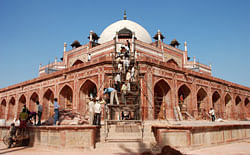Reviving a historic relic

The historic city of Delhi is home to a string of monuments. Standing tall among them is the grand Humayun’s Tomb, the finest example of Mughal architecture.
The tomb of the second Mughal emperor Humayun, built in 1565 by Humayun’s senior widow, Haji Begum, is the first monumental mausoleum to be built in the country. Coming up as it did 14 years after Humayun’s death, the monument introduced the concept of garden tomb to the Indian sub-continent. Its unique beauty is said to be the inspiration behind several major architectural innovations, culminating in the construction of the unparalleled Taj Mahal.
Humayun, son of Mughal empire founder Babur, had travelled widely in the Islamic world, notably Persia and Central Asia. The Begum is said to have given shape to the ideas he brought back from his expeditions, in this tomb. The Begum and over 150 rulers of the Mughal dynasty and their relatives lie buried here. The last Mughal emperor, Bahadur Shah Zafar II, had taken refuge in this tomb during the first War of Independence in 1857.
Designed by Sayyid Muhammad and his father, Mirak Sayyid Ghiyath, Persian architects from Herat in the present-day Afghanistan, the monument exemplifies the formative stage of the Mughal structural style. Centuries after it was built, the tomb, a World Heritage Site, has caught the imagination of thousands of visitors, the recent amongst them being US President Barack Obama.
Constructed completely in rubble masonry, the structure is the earliest example of the use of red sandstone and white marble in large quantities. Situated in south-east Delhi, the splendour of this monument becomes evident as you enter the grandiose double-storeyed gateway. Set in the centre is a garden in the classical Mughal char-bagh pattern, a high wall that surrounds the garden on three sides, the fourth side being bound by what was once the bank of River Yamuna, now diverted. Representing the earliest example of the causeways and channels, you are led to the mausoleum which itself is on a high, wide, terraced platform with small arched cells along the sides.
As you enter the expansive garden through the imposing gateway, what strikes you instantly is that this is one of the best-preserved Mughal monuments in Delhi. As you walk though the bisecting water channels with paved walkways, you reach the tomb which sits at the centre of a plinth, about 21 feet high. From the ground, the top of its central dome, double layered, reaches 140 feet. While the outer layer supports the white marble exterior, the rest of the tomb gains richness through red sandstone with white marble ornamentation. The sarcophagus of Humayun is found in the central domed chamber. Although the architect was a Persian from Afghanistan, the tomb does contain distinctly Indian aspects, such as the domed pavilions that surround the central dome.
Perhaps because of its uniqueness, the tomb has always been popular. This is true even to this day with efforts made by institutions such as the Aga Khan Trust for Culture (AKTC), which is involved in the conservation efforts for a decade now. This has made the monument retain its original form, character and purpose intact.
The AKTC took up the $ 6,50,000 project of tomb restoration in 2000, in collaboration with the Archaeological Survey of India, under the aegis of the National Culture Fund. The objective of this first privately funded restoration of a World Heritage Site in India was to revitalise the gardens, pathways, fountains and water channels of the char-bagh surrounding the tomb. Under this included main elements such as reinstating the walkways and conserving the edging stones, repair, extension and reactivation of the irrigation system, etc. Site works encompassed a variety of disciplines, including archaeological excavation, the application of conservation science and hydraulic engineering. The project ended in 2003 and is currently being followed up with a management plan that is underway for the long-term sustainability of the enhanced site.
The mammoth task involved the removal of 3,000 truckloads of earth, planting of 30 acres of lawn, preparation of 3,000 metre of hand-dressed red sandstone slabs, creation of 128 ground-water recharge pits and the de-silting and creation of other wells as part of the largest rainwater-harvesting system scheme in any heritage site in India, planning and installation of a new water circulation system for the walkway channels, planting of trees and plants, repair of fountains, etc.
According to Ratish Nanda, conservation architect and the head of the tomb restoration project, conservationists from AKTC undertook a sustained programme of archival research in Delhi, Agra, Dehradun and abroad before project implementation. “This included early 19th century drawings, visitor comments from the early 17th century, an almost continuous record of pictures from 1849 onwards, planting plans of 1880 and early 20th century, and a detailed record of the significant work done in the garden during 1903-11,” he says.
The project stands out for its excellence in craftsmanship. Conservation work currently being undertaken on the mausoleum and associated buildings required the careful removal of over one million kg of 20th century concrete from the roof and the dome.
Restoration of the stone paving on the lower plinth required the manual lifting of 12,000 sq m of stone blocks, most weighing over 1,000 kilos. In 2009-10, concrete layers were removed to expose the original stone paving, which were then lifted and reset in appropriate slopes.
Once the project is complete, the eight canopies on the dome of the 16th century monument will be restored to their original striking blue, yellow and green colour tiles as per the original Mughal design and architecture.
What is striking in the conservation work is the technology that was used. This Swiss technology, termed high-definition survey, has assisted archaeologists and conservationists in getting accurate data and records of the entire Humayun’s Tomb complex. The scan-station can even detect cracks of up to one mm thickness and deteriorating stonework/ waterlogging or other forms of stress in the buildings.
